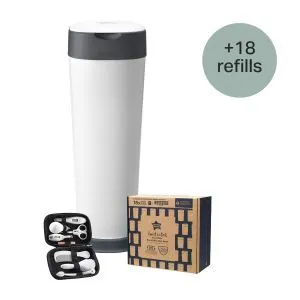
Ultimate XL Nappy Disposal Bundle with 18 Refills
Bundle & Save 40%
Subscription orders can be cancelled at anytime. Free delivery on all subsequent subscription orders. Find out more about subscriptions.
They’re easy and fuss free
Your products are automatically sent to you
You save up to 10% when you sign up for a subscription
You can cancel at any time

After your baby has spent so long in the womb, it can be a little stressful for them being exposed to the noisy outside world.
White noise is a parenting phenomenon, and a tool commonly used as an effective way of comforting distressed and crying babies.
White noise is a calming, continuous sound that's mostly used to mask unwanted noise and mimic the continuous sounds your baby hears in the womb.
People sometimes say that white noise sounds like the static that comes from an untuned radio or television. It reduces stress, soothes them to sleep, and stops them being woken by loud or sudden background noises.
And it's not just for babies, parents can benefit from this snoozy sound, too!
Explore the Range
If you're interested in using sound to soothe your baby, you can consider making it a regular part of their bedtime routine.
Because we are creatures of habit (and babies are no different), it's a good idea to start getting your baby ready for bed at the same time each evening. Be sure to look out for their sleepy cues, and keep the environment around them calm.
You can lead with a warm bath and some cosy story-reading, and once they're ready to catch some ZZZ's, you can dim the lights, and switch on a soothing sound device to help them doze off.
No, white noise isn’t bad for babies. When used correctly, it can soothe newborns, mimic the sounds of the womb, and help block out background noise so your baby can sleep more soundly.
Here are a few practical tips to keep white noise safe and effective:
Think of white noise as a tool, not a must-have. It’s a great way of giving your baby a helping hand to wind down when the world feels a bit too bright or busy.
White noise for babies should be no louder than 50 decibels, that’s about the volume of a soft shower or a quiet conversation at home. Loud enough to soothe, but not so loud it risks harming their hearing or overstimulating them. If it feels calm and comforting to you, it’s probably just OK for them, too.
You should keep the white noise machine at least 2 metres away from your baby’s sleep space, whether that’s their pram, moses basket, or cot.
There’s no set age when you have to stop using white noise for your baby, it’s more about what works for your child and your routine. Many parents start to phase white noise out sometime between 12–18 months, but others continue using it well into toddlerhood and beyond.
Signs that you should wean off white noise:
The Tommee Tippee Deammaker uses pink noise to help settle babies and encourage them to sleep better, for longer.
Pink noise is the most balanced and natural of all sounds - it's like soothing background noise. It encourages deeper sleep whilst enhancing slow brain wave activity which is critical for memory and learning efficiency.
According to the Sleep Foundation "like white noise, pink noise is a broadband sound containing components from across the sound spectrum”. Pink noise sounds are lower pitched than white noise. Researchers have compared the sound of pink noise to the noise produced by a waterfall.